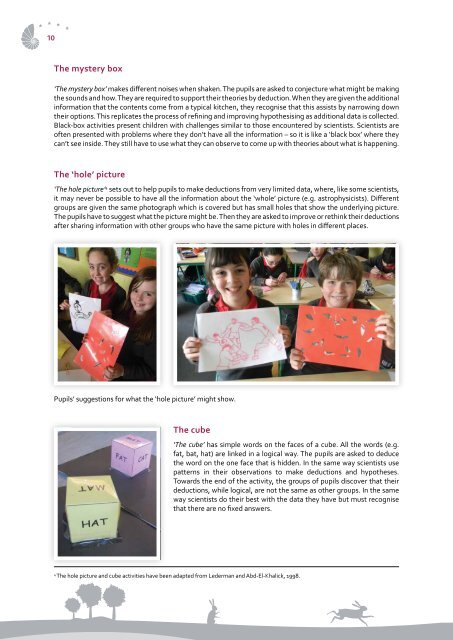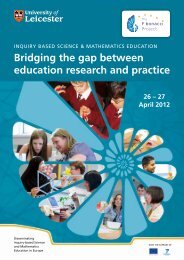Integrating Science Inquiry Across the Curriculum - Fibonacci-Project
Integrating Science Inquiry Across the Curriculum - Fibonacci-Project
Integrating Science Inquiry Across the Curriculum - Fibonacci-Project
You also want an ePaper? Increase the reach of your titles
YUMPU automatically turns print PDFs into web optimized ePapers that Google loves.
10<br />
The mystery box<br />
‘The mystery box’ makes different noises when shaken. The pupils are asked to conjecture what might be making<br />
<strong>the</strong> sounds and how. They are required to support <strong>the</strong>ir <strong>the</strong>ories by deduction. When <strong>the</strong>y are given <strong>the</strong> additional<br />
information that <strong>the</strong> contents come from a typical kitchen, <strong>the</strong>y recognise that this assists by narrowing down<br />
<strong>the</strong>ir options. This replicates <strong>the</strong> process of refining and improving hypo<strong>the</strong>sising as additional data is collected.<br />
Black-box activities present children with challenges similar to those encountered by scientists. Scientists are<br />
often presented with problems where <strong>the</strong>y don’t have all <strong>the</strong> information – so it is like a ‘black box’ where <strong>the</strong>y<br />
can’t see inside. They still have to use what <strong>the</strong>y can observe to come up with <strong>the</strong>ories about what is happening.<br />
The ‘hole’ picture<br />
‘The hole picture’ 4 sets out to help pupils to make deductions from very limited data, where, like some scientists,<br />
it may never be possible to have all <strong>the</strong> information about <strong>the</strong> ‘whole’ picture (e.g. astrophysicists). Different<br />
groups are given <strong>the</strong> same photograph which is covered but has small holes that show <strong>the</strong> underlying picture.<br />
The pupils have to suggest what <strong>the</strong> picture might be. Then <strong>the</strong>y are asked to improve or rethink <strong>the</strong>ir deductions<br />
after sharing information with o<strong>the</strong>r groups who have <strong>the</strong> same picture with holes in different places.<br />
Pupils’ suggestions for what <strong>the</strong> ‘hole picture’ might show.<br />
The cube<br />
‘The cube’ has simple words on <strong>the</strong> faces of a cube. All <strong>the</strong> words (e.g.<br />
fat, bat, hat) are linked in a logical way. The pupils are asked to deduce<br />
<strong>the</strong> word on <strong>the</strong> one face that is hidden. In <strong>the</strong> same way scientists use<br />
patterns in <strong>the</strong>ir observations to make deductions and hypo<strong>the</strong>ses.<br />
Towards <strong>the</strong> end of <strong>the</strong> activity, <strong>the</strong> groups of pupils discover that <strong>the</strong>ir<br />
deductions, while logical, are not <strong>the</strong> same as o<strong>the</strong>r groups. In <strong>the</strong> same<br />
way scientists do <strong>the</strong>ir best with <strong>the</strong> data <strong>the</strong>y have but must recognise<br />
that <strong>the</strong>re are no fixed answers.<br />
4<br />
The hole picture and cube activities have been adapted from Lederman and Abd-El-Khalick, 1998.




